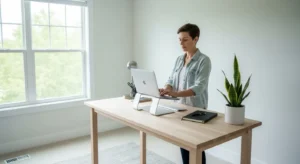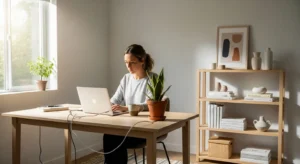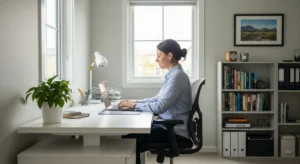
Living in a small apartment presents a unique set of challenges. The dining table becomes the office, the sofa doubles as a filing cabinet, and the kitchen counter is a graveyard for mail, keys, and half-finished projects. This constant overlap creates a subtle but persistent sense of chaos. It’s not just messy; it’s a source of mental drain. Every time you sit down to work, you first have to excavate your laptop from a pile of life’s debris. This is what we call visual friction: the mental and physical resistance created by a cluttered or disorganized environment. Your brain has to work harder to filter out the noise before you can even begin the task at hand.
Many people believe the solution is an iron will—a commitment to “just be more organized.” But at The Focused Method, we believe in a different approach. Instead of relying on finite willpower, we design systems and environments that make focus the path of least resistance. The goal isn’t a sterile, magazine-perfect home; it’s a calm, low-maintenance space that supports your goals without demanding constant upkeep. It’s about creating a dedicated productivity corner, even in the smallest of apartments, that cues your brain to focus and makes your work flow almost effortlessly.
This guide will walk you through the exact steps to carve out and maintain that space. We will move beyond simple decluttering tips and into the realm of sustainable systems. You will learn how to use simple environmental cues to your advantage, establishing daily and weekly resets that take minutes, not hours. Forget the struggle and the willpower. It’s time to design a space that works for you, so you can finally do your best work at home.
📚 Table of Contents
- The Foundation: Zoning and Flow for Effortless Organization
- Assigning a “Home” for Everything
- The Power of the “One-Touch Rule”
- Creating “Working Zones” to Reduce Decision Fatigue
- A Gentle Approach to Labeling
- Building Habits: The Simple Magic of Daily and Weekly Resets
- Your 10-Minute Daily “Reset Point” Routine
- Taming the Paper Dragon: The Desk and Inbox Reset
- Don’t Forget Digital: A Quick Guide to Digital Organization
- Mastering Small Spaces: Practical Strategies for Your Apartment
- Think Vertically: The Untapped Potential of Your Walls
- Multi-Functional Furniture is Your Best Friend
- Working in Shared Spaces Without Losing Your Mind
- Low-Cost Storage That Doesn’t Look Cheap
- Real-World Examples: Two “Productivity Corner” Makeovers
- Frequently Asked Questions About Small Space Productivity
- Your First Steps to a Calmer, More Productive Space
The Foundation: Zoning and Flow for Effortless Organization
Before you buy a single storage bin or label maker, you must first understand the principles of flow. A truly organized space isn’t about having the least amount of stuff; it’s about ensuring every item has a logical place and a clear purpose. This foundational step is what separates a temporarily tidy desk from a permanently productive corner. We achieve this by minimizing decision-making and creating intuitive pathways for your daily tasks.
Assigning a “Home” for Everything
Every single object in your productivity corner, from a single pen to your laptop charger, needs a designated “home.” This isn’t just a place where it gets tossed at the end of the day. A home is a specific, logical, and easy-to-access spot. Think about your workflow. Where do you naturally reach for a pen? That’s where the pen cup should live. Where does mail accumulate? That spot needs an inbox tray. When an item has a home, you never have to ask, “Where should I put this?” The answer is already decided. This simple act of pre-decision eliminates dozens of tiny moments of friction throughout your day, conserving your mental energy for more important work.
The Power of the “One-Touch Rule”
Once items have a home, the next step is to get them there efficiently. We teach the one-touch rule, a simple but transformative habit. The principle is this: whenever you pick up an item, you deal with it completely in that one touch. Take a piece of mail, for example. Instead of putting it on the counter to “deal with later,” you immediately apply the one-touch rule. You open it, decide what it is—a bill to pay, a magazine to read, or junk to recycle—and act on it immediately. The bill goes into your “to-pay” folder, the magazine goes to your reading nook, and the junk mail goes directly into the recycling bin. You have touched it once and completed its journey. This prevents the formation of clutter piles, which are nothing more than deferred decisions.
Creating “Working Zones” to Reduce Decision Fatigue
Even a small desk can be divided into working zones. These are conceptually distinct areas dedicated to specific types of tasks. By creating zones, you provide your brain with powerful environmental cues. Your brain learns to associate a particular space with a particular activity, making it easier to transition into a state of focus. For example, your small desk could have three zones. The central zone is your digital hub, home to your laptop or monitor. The right side might be your analog zone, with a notepad and your favorite pen for brainstorming or journaling. The left side could be your processing zone, containing a small inbox tray for incoming items and an outbox for things that need to be filed or acted upon. When you sit down, the physical layout of your desk guides your actions, reducing the mental effort required to get started.
A Gentle Approach to Labeling
While many organization systems rely heavily on detailed labels, we advocate for a label-light approach that reduces visual friction. Instead of plastering every box and folder with a typed label, let the container and its location serve as the label. For instance, a clear acrylic drawer organizer on your desk doesn’t need labels for “pens,” “paper clips,” and “sticky notes.” You can see what’s inside. A specific magazine file that *always* holds your “To Read” articles doesn’t need a label; its consistent purpose and placement are the label. This approach creates a cleaner, calmer visual field, allowing your mind to focus on your work, not on processing the organizational system itself. Use labels only where an item’s contents are not immediately obvious, such as on opaque storage boxes for archival files.

Building Habits: The Simple Magic of Daily and Weekly Resets
A beautifully designed productivity corner for a small apartment will not stay that way on its own. The key to long-term success is not a massive, once-a-month cleaning blitz, but rather a series of small, consistent habits that prevent chaos from ever taking hold. These habits are built around the concept of reset points, which are designated, short blocks of time where you return your space to its baseline state of order. This isn’t about deep cleaning; it’s about maintenance. By integrating these quick resets into your routine, you ensure your productivity space is always ready for you when you need it.
Your 10-Minute Daily “Reset Point” Routine
The most important habit you can build is the 10-minute daily reset. Schedule this at a consistent time each day, typically at the end of your workday. Set a timer for ten minutes—no more, no less. The goal is not perfection, but progress. During this time, you have one mission: return every item in your productivity corner to its designated home. The coffee mug goes back to the kitchen. The pens return to their cup. The loose papers are placed in the inbox tray. The books are reshelved. You are simply closing the “loops” that were opened during the day. This small ritual does more than just tidy up; it signals to your brain that the workday is officially over, helping you create a healthier boundary between work and life, which is especially crucial in a small apartment.
Taming the Paper Dragon: The Desk and Inbox Reset
Paper is one of the biggest sources of clutter and friction in any workspace. A weekly paper reset is essential to keep it under control. Once a week, perhaps on a Friday afternoon, dedicate 15 minutes to fully process your physical inbox. Using the one-touch rule, handle every piece of paper. This means you will do one of three things with each item: act, file, or discard. “Act” items might be bills to pay or forms to sign—do them right then if they take less than two minutes. “File” items are documents you need to keep, which go into your simple filing system. “Discard” items are either shredded or recycled. By never letting your inbox overflow, you prevent the anxiety and overwhelm that comes from a mountain of unprocessed paper. You know that everything important has been handled, and your desk surface is clear and ready for the week ahead.
Don’t Forget Digital: A Quick Guide to Digital Organization
In today’s world, digital clutter can cause just as much friction as physical clutter. A chaotic desktop filled with random files and a bulging email inbox are the digital equivalents of a messy desk. Apply the same principles to your digital space. Create a simple, logical folder structure for your documents. We recommend a broad, action-based system, such as folders named “Active Projects,” “Reference,” “Archive,” and “To Sort.” Your computer desktop should be treated like your physical desk—a temporary work surface, not a permanent storage facility. At the end of each day, during your 10-minute reset, drag any new files from your desktop into the “To Sort” folder. Then, during your weekly reset, take ten minutes to move everything from “To Sort” into its proper, permanent home. For notes and web clippings, a tool like Evernote can serve as a powerful digital filing cabinet, keeping your main document folders clean and streamlined.
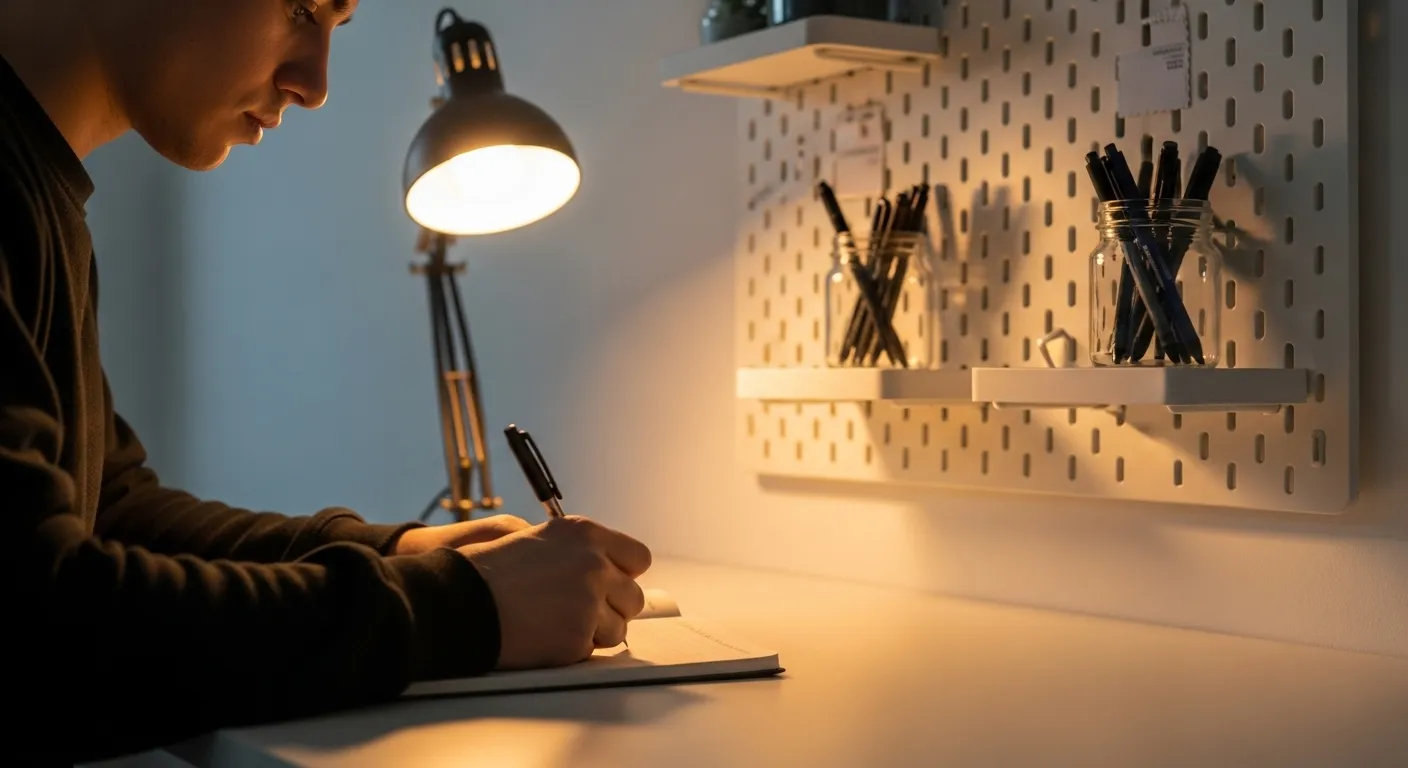
Mastering Small Spaces: Practical Strategies for Your Apartment
The core challenge of creating a productivity corner for a small apartment is, of course, the lack of space. When every square foot is precious, you must be creative, strategic, and ruthless about what earns a place in your home. The key is to maximize the utility of the space you have, rather than wishing for more. This means looking at your apartment with fresh eyes and seeing potential in unconventional places. With the right strategies, even the tiniest studio can accommodate a functional and inspiring workspace.
Think Vertically: The Untapped Potential of Your Walls
When floor space is limited, the only way to go is up. Your walls are your greatest asset in a small space. Install simple floating shelves above your desk to get papers, books, and supplies off your primary work surface. A wall-mounted grid or pegboard system is an incredibly versatile option, allowing you to hang cups for pens, small shelves for supplies, and clips for important notes. This not only frees up your desk but also keeps your most-used tools within easy reach, reducing the friction of having to search through drawers. By moving storage from the horizontal plane to the vertical one, you can dramatically increase the functionality of a small footprint.
Multi-Functional Furniture is Your Best Friend
In a small apartment, every piece of furniture should work hard. Seek out items that can serve two or more purposes. An ottoman with hidden storage can hold blankets or office supplies. A narrow console table can serve as a minimalist desk during the day and an entryway table in the evening. A dining table can be a fantastic workspace, provided you have a system for clearing it off. Consider a “work caddy” or tray where you keep your laptop, planner, and pens. At the end of the day, your entire office can be placed in the caddy and stored on a shelf or in a closet, instantly transforming the space back into a dining area. This approach respects the multi-purpose nature of small-space living while maintaining clear boundaries.
Working in Shared Spaces Without Losing Your Mind
If your productivity corner is in a shared area like the living room or kitchen, establishing clear boundaries is paramount. This is where zoning becomes psychological as well as physical. A small area rug under your desk and chair can visually demarcate your “office,” signaling to roommates or family that this is a zone for focus. Using headphones is another powerful cue, both for you and for others, that you are in “work mode.” Communication is also key. Agree on “focus hours” when you are not to be disturbed if possible. The goal is to create a ritual and a set of environmental cues that allow you to mentally “go to work,” even if you’ve only moved six feet from your sofa.
Low-Cost Storage That Doesn’t Look Cheap
Organizing a small space doesn’t have to be expensive. You can find elegant and effective storage solutions on a budget. Look for simple, clean-lined items in neutral colors like white, black, or natural wood. These tend to recede visually, making a small space feel less cluttered. Simple magazine files are perfect for corralling loose papers and notebooks. A set of matching, attractive boxes for shelving can hide a multitude of miscellaneous items, creating a calm and uniform look. Check out stores like The Container Store for ideas, but also look for similar items at budget-friendly retailers. The key is cohesion. A few well-chosen, matching pieces will always look more intentional and organized than a random assortment of colorful plastic bins.

Real-World Examples: Two “Productivity Corner” Makeovers
Theory is helpful, but seeing these principles in action is what makes them click. Let’s walk through two common small-apartment scenarios and see how applying a systems-focused approach can transform a frustrating space into a functional productivity corner. These are not dramatic, expensive renovations; they are practical makeovers based on the concepts of zoning, flow, and resets.
Case Study 1: The “Closet Office” Transformation
The Before: Sarah lives in a studio apartment and has a small closet filled with a jumble of office supplies, old paperwork, and miscellaneous tech gear. She works from her dining table, which means she has to clear everything away before every meal, a process she finds draining. The closet is a source of stress—she knows what she needs is in there, but finding it is an archaeological dig.
The Process: First, Sarah completely empties the closet. She applies the one-touch rule to every single item, sorting them into “keep,” “donate,” and “trash.” For the “keep” pile, she assigns a home. She buys a small, inexpensive filing cabinet for the bottom of the closet to house important documents. Above it, she installs two simple floating shelves. The lower shelf becomes the active zone. She places a single inbox tray for new papers, a cup for pens, and a charging station for her devices. The upper shelf is the supply zone, holding matching boxes for extra notebooks, printer paper, and cables. She invests in a slim, wall-mounted folding desk that can be closed up when not in use. Now, her entire office has a designated home inside the closet.
The After: Sarah’s dining table is now just for dining. When it’s time to work, she opens the closet doors, folds down her desk, and has immediate access to everything she needs in its logical place. There is no visual friction. At the end of the day, her 10-minute reset involves filing any papers from the inbox, placing her laptop on its charger, and folding the desk away. The closet doors close, and her workspace completely disappears, allowing her to mentally switch off from work. She has created a highly functional, zero-footprint productivity corner.
Case Study 2: The Kitchen Command Center
The Before: Mark’s small apartment has a section of kitchen counter that has become a black hole for clutter. It’s covered in mail, coupons, keys, receipts, and his kids’ school notices. It’s the first thing he sees when he comes home, and it immediately makes him feel overwhelmed. It’s meant to be a space to organize family life, but it has become the opposite.
The Process: Mark’s goal is to create a low-maintenance “command center.” He clears the counter completely. Recognizing the power of vertical space, he installs a small, wall-mounted magnetic whiteboard system. This system has a small board for urgent reminders, a magnetic clip for a “to-do” list, and a small hanging cup for pens. Below it, he places a three-tiered paper sorter on the counter. This becomes his primary processing tool. The top tier is the inbox for all new mail and papers. The middle tier is for “Action Items” like bills to pay and forms to sign. The bottom tier is for items “To File.” He also adds a small, decorative bowl that becomes the designated home for keys and wallets—no exceptions.
The After: The counter is now 90% clear. When mail comes in, it goes directly into the inbox tray—one touch. Once a week, during his weekly reset, Mark processes the “Action” and “To File” trays. The whiteboard provides an at-a-glance view of the family’s priorities without a flurry of sticky notes. The visual friction is gone, replaced by a calm, streamlined system that captures and organizes the logistics of life. This small productivity space isn’t for deep work, but it productively manages the flow of household information, which is just as important for a calm home.
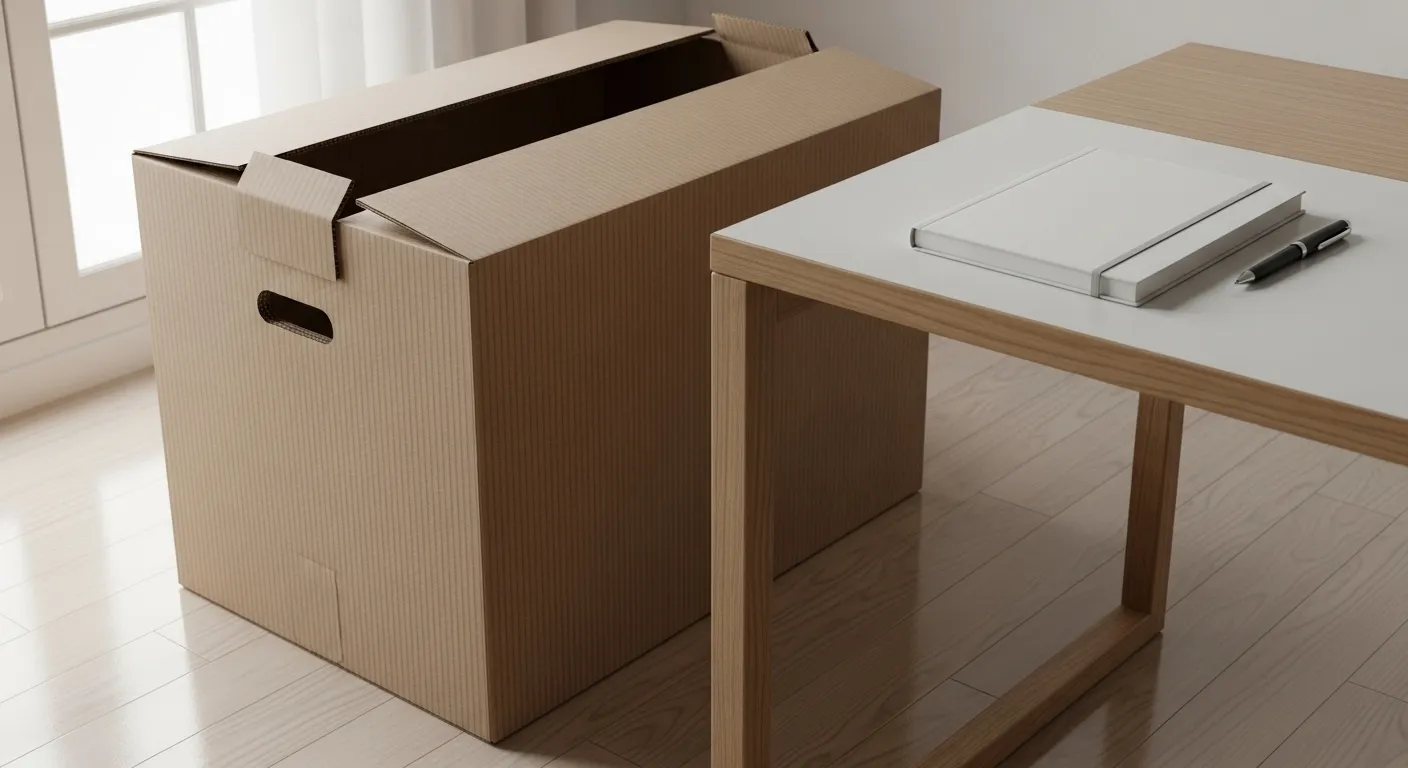
Frequently Asked Questions About Small Space Productivity
Transitioning to a systems-based approach to organization can bring up a lot of questions. Here are answers to some of the most common challenges people face when trying to create a productivity corner in a small apartment.
How do I deal with years of paper backlog before I can even start?
The backlog can feel paralyzing. Don’t try to tackle it all at once. Get a large box and label it “Archive To Sort.” Put all of your old, unsorted paperwork in this box and store it out of sight. This immediately removes the visual friction and gives you a clean slate to start your new system with today’s papers. Then, schedule 30-minute blocks in your calendar—just one or two a week—to work through the archive box. Use the “act, file, discard” method. You’ll be surprised how much of it is outdated and can be discarded, and you’ll make steady progress without derailing your efforts to build a new, forward-looking system.
My roommate/partner/family isn’t organized. How can I get them on board?
You can’t force another person to adopt your system, but you can lead by example and make the system easy to use. Focus on shared pain points. Instead of saying, “You need to be more organized,” try, “Wouldn’t it be nice if we could always find our keys?” Then, introduce the simple solution, like a designated key bowl. For your personal productivity corner, clearly define its boundaries. A small rug or a specific desk lamp can visually signal “this is my work zone.” Most people will respect a clearly delineated space. The goal is coexistence, not conversion. Keep your system simple and your space tidy, and you may find your habits start to rub off on them.
What about sentimental items that are cluttering my desk?
A productivity space is for production, not for sentiment. Your workspace needs to be a place of focus, and while a couple of small, meaningful items can be inspiring, a collection of sentimental objects creates visual friction. The solution is not to get rid of these items, but to give them a more appropriate home. Create a “memory box” or a designated shelf in another part of your apartment for these treasures. By giving them their own special place, you honor their importance while protecting the functional integrity of your workspace. You can then visit and appreciate them when you are in a reflective mood, rather than having them distract you during work hours.
My apartment is genuinely tiny. I don’t even have a corner to spare. What now?
If a permanent desk is not an option, think “portable and packable.” Your productivity space can be a “kit” rather than a location. Use a storage box or a tote bag to house your “office.” This kit would contain your laptop, charger, a notebook, pens, and any other essential supplies. When it’s time to work, you can take your kit to the dining table or even a comfortable chair with a lap desk. The most crucial part of this method is the reset at the end of the day: everything goes back into the kit, and the kit is stored away in a closet or under a bed. This defines the beginning and end of your workday and prevents your work life from spilling out and taking over your entire living space.

Your First Steps to a Calmer, More Productive Space
Creating a functional, calm productivity corner in a small apartment is not a one-time project; it’s the beginning of a new relationship with your space. The goal is to move away from the cycle of clutter and stress, and toward a system where your environment actively supports your focus. It’s about designing a space that makes the right choices—the productive choices—the easiest ones to make. You don’t need more willpower or a bigger apartment; you need smarter systems and a few consistent habits.
The journey starts with small, deliberate actions. Don’t try to overhaul your entire apartment this weekend. Instead, commit to establishing a few foundational reset points that will build momentum and deliver an immediate sense of control and calm. The feeling of starting your day at a clear, ready-to-use workspace is a powerful motivator.
Here are three simple resets you can start this week to begin building your productivity corner. First, identify a single surface that will become your dedicated workspace and clear it completely. This is your blank slate. Second, define a single “home” for the five most-used items on that desk, such as your laptop, a pen, and a notebook, and commit to returning them to that spot at the end of each day. Finally, schedule a 10-minute “end-of-day reset” in your phone’s calendar for every workday this week. When the alarm goes off, stop what you are doing and take just those ten minutes to return your new, small workspace to its baseline state. These small wins are the building blocks of a truly organized and productive life.
Disclaimer: The information provided in this article is for informational purposes only and does not constitute professional, financial, or legal advice. Please consult with a qualified professional for advice tailored to your specific situation.
For expert guidance on productivity and focus, visit National Sleep Foundation, American Institute of Stress, Mindful.org, American Psychological Association (APA) and Society for Industrial and Organizational Psychology (SIOP).


